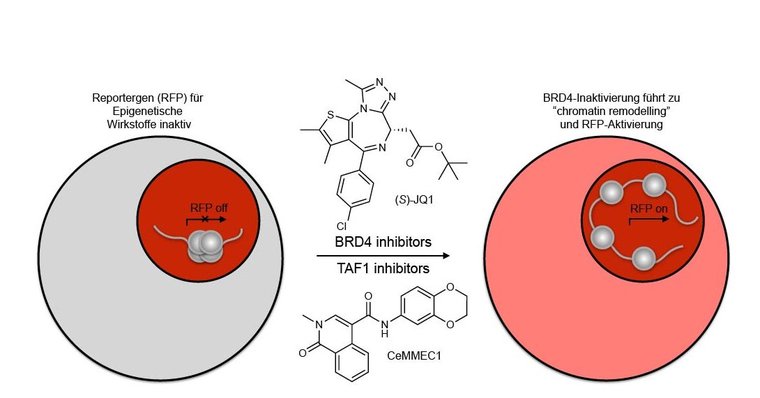Red glowing cells reveal new epigenetic targets against leukemia
Share
Epigenetic modifications are an important factor in cancer development and a promising target for its treatment. With red glowing cells, CeMM researchers in collaboration with groups at Oxford University and IMP Vienna found new small molecules, which trigger specific epigenetic modifications and thus are promising compoundsforthe treatment of blood born cancers. Their study was published in Nature Chemical Biology.
For Stefan Kubicek, red light means hitting the bull´s eye: His research group at CeMM developed fluorescent cell lines which signal the inhibition of specific epigenetic modifications by bright red radiance. When a substance behaves like a so-called “BRD4 bromodomain inhibitor”, those engineered cells start to glow. Nearly 90.000 chemical compounds could be tested by this method in CeMM’s highly automated facilities, 22 out of them showed BRD4 bromodomain inhibitor-like properties. Notably, this set contained all previously known BRD4 inhibitors, plus 13 novel chemical structures.
The two most promising novel compounds were examined in detail – one of them turned out to be a promising candidate for future cancer therapies. It affects a protein called TAF1, which has not previously been linked to BRD4 biology. “We could show that TAF1 directly interacts with BRD4 and that our new TAF1 inhibitor has the same effect as a BRD4-inhibitor” says Sara Sdelci, PostDoc in Kubicek’s Lab and first author of the study.
In further studies, Stefan Kubicek’s team, in collaboration with Susanne Müller and Stefan Knapp from Oxford University, Johannes Zuber from the Vienna Institute for Molecular Pathology (IMP), Giulio Superti-Furga and Christoph Bock from CeMM, could show that TAF1 inhibitors and BRD4 inhibitors synergize in leukemia cells. When the newly discovered compound is used in combination with BRD4 Inhibitors, its cancer-killing effect is strongly increased.
Publication:
Sara Sdelci, Charles-Hugues Lardeau, Cynthia Tallant, Freya Klepsch, Björn Klaiber, James Bennett, Philipp Rathert, Michael Schuster, Thomas Penz, Oleg Fedorov, Giulio Superti-Furga, Christoph Bock, Johannes Zuber, Kilian V. M. Huber, Stefan Knapp, Susanne Müller and Stefan Kubicek. Mapping the chemical chromatin reactivation landscape identifies BRD4-TAF1 cross-talk.Nature Chemical Biology. DOI: 10.1038/nchembio.2080
Funding:
This project was supported by SFB grant F4710 of the Austrian Science Fund (FWF). Sara Sdelci acknowledges support by JDRF postdoctoral fellowship 3-PDF-2014-206-A-N “Reprogramming by Loss of Function”.

